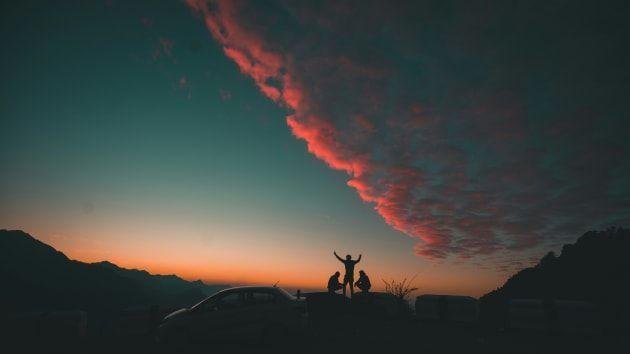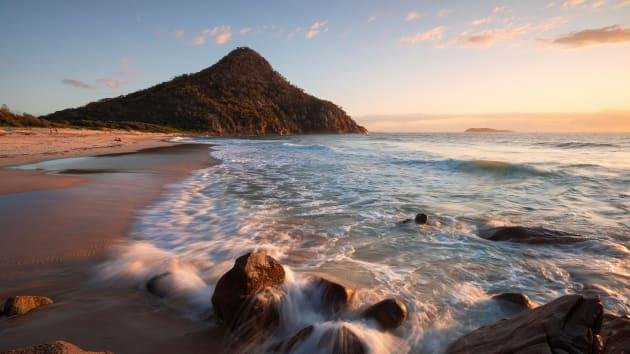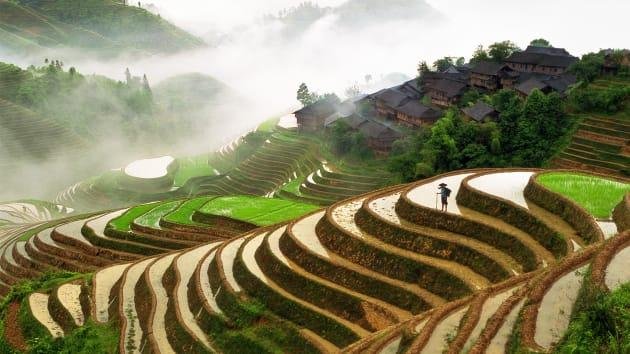With travel ground to a halt and millions of people confined to their homes, global spirits could use some uplifting.
From the smell of freshly-cut grass to the sight of a sunrise peeking above a tropical horizon, nothing can replace spending time in the Great Outdoors.
But simply looking at photographs of nature for as few as five minutes can have a similar, calming effect on the brain.
“There are studies that show that looking at pleasant images can provide a type of mental escape for individuals during times of moderate stress,” said Sandra Sgoutas-Emch, a psychological sciences professor at the University of San Diego. “For example, a study out of the Netherlands in 2015 found that having students look at pictures of nature helped to reduce their stress reaction during a stress test, versus pictures of buildings.”
Looking at relaxing imagery can also be viewed as a form of mindfulness meditation which activates the parasympathetic system, she added, referring to the part of the nervous system that helps us relax and “quiet the areas of the brain that are involved in fear and anxiety.”

The type of images we look at matters. Fractals – a mathematical term for never-ending patterns – have a particularly strong calming effect on the parasympathetic system.
Studies indicate that looking at fractals increases alpha brain waves, as well as blood flow, to the parahippocampus and other areas of the brain that regulate emotions.
Fractals are common in nature and can be seen in everything from leaves and snowflakes to lightning bolts, clouds, ferns, cacti and snail shells.
Take a look at the travel photos below, and gauge your stress levels before and after you finish reading.
Clouds

This photo was taken on a hill station located at an altitude over 6,500 feet above sea level in a place known as “The Queen of the Hills.”
Home to more than 30,000 people, the area has a wildlife sanctuary, a nature walk known as Camel’s Back, a Tibetan temple known as Happy Valley (said to be the first Tibetan temple in Indiay) and a popular spot called Lake Mist where travelers can boat and swim in waterfalls.
A town high on romance and charm, the area attracts many tourists, including honeymooners from across the sub-continent. Education is also a draw; Christian residents have been attending the Woodstock School since it first opened here in 1854.
Location: Mussoorie, India
Bamboo

A common sight in college dorm rooms, office reception areas and computers in sleep mode, this famous scene goes beyond the calming patterns at play. It is in fact a real place in a city that is home to zen gardens and over 1,600 temples.
This bamboo forest covers around six square miles and has nearly 1,000 feet of pathways. Weekday mornings are said to provide the most secluded experience, when slivers of light pierce through the bamboo trees and cast long spindly shadows onto the forest floors.
The practice of “forest bathing” was coined in this country, where inhabitants have long revered bamboo for its structural and edible qualities.
Location: Arashiyama Bamboo Grove in Kyoto, Japan
Night lights

Mother Nature’s most spectacular light show can be seen from a number of countries including Canada, Greenland, Iceland, Norway, Sweden and the United States (Alaska). But this location is known for being one of the top spots to see the Northern Lights from accommodations that range from igloos made of glass or snow to luxury treehouses.
During the early summer months, the sun shines for two months straight in a phenomenon known as midnight sun. And the area, which is about as big as Belgium, Holland and Switzerland combined, has more reindeer (200,000) than people (184,000).
Location: Lapland, Finland
Fall foliage

As summer and fall travel will likely see a return of the road trip, travel along beautiful highways like this one are predicted to dominate travel in the latter part of 2020.
This lake was created by a dam built in the Skagit River in 1930. Set among towering mountains, the turquoise color of the lake is the result of glacial waters that flow into it. A popular overlook is built along the North Cascades Highway, which is said to be one of the most beautiful drives in the world.
The lake — one of 500 in the national forest where it sits — is well known though not easily accessed. Camping is mostly accessible by boat only, and a trail to reach it is seven miles long, both in and back, which ensures visits are quiet and serene.
Location: Diablo Lake in Washington, U.S.
The desert twilight

The quiver trees shown in this sunset image aren’t trees at all, but rather large succulent aloe plants. They are named after the practice of local San bushmen, who once used the plant’s hollowed branches to make quivers for hunting arrows.
With leaves that resemble roots, the trees are famous for looking like they grow upside down. They’ve adapted to the arid conditions of the desert, with thick waxy leaves and branches that are coated in white powder that reflect the sun.
Just a few quiver forests exist in the world, with the one shown here home to plants — known as kokerbooms in Afrikaans — that are estimated to be two to three centuries old. The forest was declared a national monument in 1995.
Location: Quiver Tree Forest near Keetmanshoop, Namibia
Waterfalls

People have traveled to see this waterfall as far back as 1875, when it was on private property. The family who owned it eventually built a trail for people that led to the falls.
The gorge was formed by flash flooding, which still occurs today. When it happens, the 105-foot gorge fills completely to the top with the falls, spilling enough water to fill an Olympic-sized swimming pool every second.
Together with the Geysir geothermal area and Thingvellir National Park, the waterfall forms what is known by travelers as the “Golden Circle” — a popular day trip from Reykjavik. It also graced the cover of Echo & the Bunnymen’s highest-charting album “Porcupine.”
Location: Gullfoss, in southwest Iceland
The ocean blue

Home to some of the most exciting diving in the world, this island complex boasts manta rays, bottlenose dolphins, great white sharks and massive humpback whales.
Every year, around 1,200 humpback whales migrate to this area of the Pacific Ocean to mate or deliver offspring. Divers have been able to get extraordinarily close to the whales in recent years.
Location: Near Mexico’s Revillagigedo Islands
Coastal beaches

Protected on both sides by hills, this quiet beach offers golden sands, rugged scenery and peaceful surroundings. More popular with walkers than swimmers, this deserted piece of paradise sits within Tomaree National Park.
Old-school movie buffs will enjoy the area; “Mad Max” — the raw, 1979 version — was filmed nearby. Travelers with other interests can drop in for World War II relics, whale watching and koala sightings.
Location: Zenith Beach in New South Wales, Australia
Ice and snow

At more than a mile deep, this is the deepest lake in the world. It contains more than 20% of all fresh surface water in the world. A UNESCO World Heritage site, it is home to seals, bears, wolves, elk and reindeer and some 27 islands, the largest of which is 45 miles long and home to 1,500 people.
More than half a million travelers visit the lake every year to skate, fish and hike on the ice, which in the winter can be two meters thick.
Location: Elenda Island on Lake Baikal, Siberia
Starry, starry skies

A good night of stargazing depends on the absence of city lights and the luck of a cloudless sky. That’s why the desert has such stellar star-watching potential.
Here, companies arrange stargazing services that start from a one-night sampler to five-day astronomy trips into the dunes to learn about Bedouin mythology and traditions, while sleeping under the stars of Erg Chebbi.
Location: Outside Merzouga, Morocco
Mountain terraces

Rice flourishes in submerged water along rainy lowlands and water-logged river deltas. Inhabitants of mountainous estates have to get a little more creative.
Terraced rice fields have existed for centuries in Japan, Vietnam, Indonesia, the Philippines and many regions in this country.
These fields, nicknamed the Dragon’s Backbone, are estimated to be around 650 years old. Travelers come to hike and photograph the fields, which glimmer with water in the early spring, turn into a sea of emerald green in the summer, and mellow into a golden yellow during the autumn harvest period.
Location: Longsheng, China